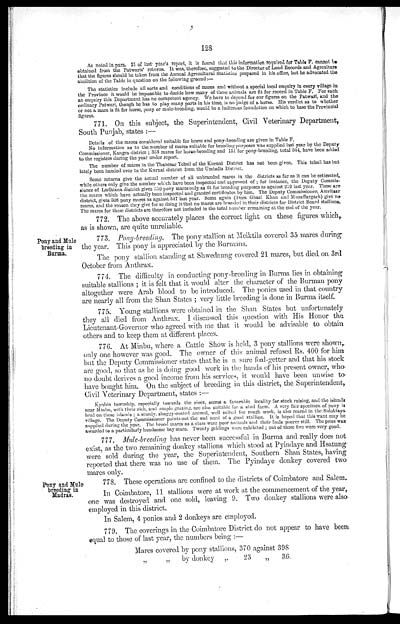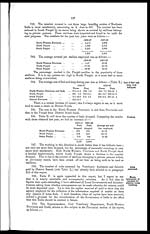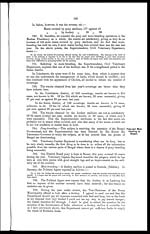Medicine - Veterinary > Civil Veterinary Departments > Annual administration report of the Civil Veterinary Department of India > 1897-1898 > Part II - Provincial report
(146) Page 128
Download files
Individual page:
Thumbnail gallery: Grid view | List view

128.
As noted in para. 21 of last year's report, it is found that this information required for Table F. cannot be-
obtained from the Patwaris' returns. It was, therefore, suggested to the Director of Land Records and Agrculture
that the figures should be taken from the Annual Agricultural Statistics prepared in his office, but he advocated the
abolition of the Table in question on the following ground:—
The statistics include all sorts and conditions of mares and without a special local enquiry in every village in
the Province it would be impossible to decide how many of these animals are fit for record in Table F. For such
an enquiry this Department has no competent agency. We have to depend for our figures on the Patwari, and the
ordinary Patwari, though he has to play many parts in his time, is no judge of a horse. His verdict as to whether
or not a mare is fit for horse, pony or mule-breeding, would be a ludicrous foundation on which to base the Provincial
figures.
771. On this subject, the Superintendent, Civil Veterinary Department,
South Punjab, states :—
Details of the mares considered suitable for horse and pony-breeding are given in Table F.
No information as to the number of mares suitable for breeding purposes was supplied last year by the Deputy
Commissioner, Kangra district; 353 mares for horse-breeding and 151 for pony-breeding, total 504, have been added
to the registers during the year under report.
The number of mares in the Thanesar Tehsil of the Kurnal District has not been given. This tehsil has but
lately been handed over to the Kurnal district from the Umballa District.
Some returns give the actual number of all unbranded mares in the districts as far as it can be estimated,
while others only give the number which have been inspected and approved of; for instance, the Deputy Commis-
sioner of Ludhiana district gives 350 pony mares only as fit for breeding purposes as against 250 last year. These are
the mares which have actually been inspected and granted certiffcates by him. The Deputy Commissioner, Amritsar
district, gives 508. pony mares as against 547 last year. Some again (Dera Ghazi Khan and Muzaffargarh) give no
mares, and the reason they give for so doing is that no mares are branded in their districts for District Board stallions.
The mares for these districts are therefore not included in the total number remaining at the end of the year.
772. The above accurately places the correct light on these figures which,
as is shown, are quite unreliable.
Pony and Mule
breeding in
Burma.
773. Pony-breeding. The pony stallion at Meiktila covered 35 mares during
the year. This pony is appreciated by the Burmans.
The pony stallion standing at Shwedaung covered 21 mares, but died on 3rd
October from Anthrax.
774. The difficulty in conducting pony-breeding in Burma lies in obtaining
suitable stallions; it is felt that it would alter the character of the Burman pony
altogether were Arab blood to be introduced. The ponies used in that country
are nearly all from the Shan States; very little breeding is done in Burma itself.
775. Young stallions were obtained in the Shan States but unfortunately
they all died from Anthrax. I discussed this question with His Honor the
Lieutenant-Governor who agreed with me that it would be advisable to obtain
others and to keep them at different places.
776. At Minbu, where a Cattle Show is held, 3 pony stallions were shown,
only one however was good. The owner of this animal refused Rs. 400 for him
but the Deputy Commissioner states that he is a sure foal-getter and that his stock
are good, so that as he is doing good work in the hands of his present owner, who
no doubt derives a good income from his services, it would have been unwise to
have bought him. On the subject of breeding in this district, the Superintendent,
Civil Veterinary Department, states :—
Kyabin township, especially towards the river, seems a. favorable locality for stock raising, and the islands
near Minbu, with their rich, and ample grazing, are also suitable for a stud farm. A very fair specimen of pony is
bred on these islands; a sturdy, shaggy-coated animal, well suited for rough work, is also reared in the Sidoktaya
village. The Deputy Commissioner points out the sad need of a good stallion. It is hoped that this want may be
supplied during the year. The brood marcs as a class were poor animals and their foals poorer still. The prize was
awarded to a particularly handsome bay maro. Twenty geldings were exhibited; out of these five were very good.
777. Mule-breeding has never been successful in Burma and really does not
exist, as the two remaining donkey stallions which stood at Pyindaye and Hsatung
were sold during the year, the Superintendent, Southern Shan States, having
reported that there was no use of them. The Pyindaye donkey covered two
mares only.
Pony and Mule
breeding in
Madras.
778. These operations are confined to the districts of Coimbatore and Salem.
In Coimbatore, 11 stallions were at work at the commencement of the year,
one was destroyed and one sold, leaving 9. Two donkey stallions were also
employed in this district.
In Salem, 4 ponies and 2 donkeys are employed.
779. The coverings in the Coimbatore District do not appear to have been
equal to those of last year, the numbers being :—
|
Mares covered by pony stallions, |
370 |
against |
398 |
|
„ „ by donkey „ |
23 |
„ |
36 |
Set display mode to: Large image | Zoom image | Transcription
Images and transcriptions on this page, including medium image downloads, may be used under the Creative Commons Attribution 4.0 International Licence unless otherwise stated. ![]()
| India Papers > Medicine - Veterinary > Civil Veterinary Departments > Annual administration report of the Civil Veterinary Department of India > 1897-1898 > Provincial report > (146) Page 128 |
|---|
| Permanent URL | https://digital.nls.uk/75505457 |
|---|




